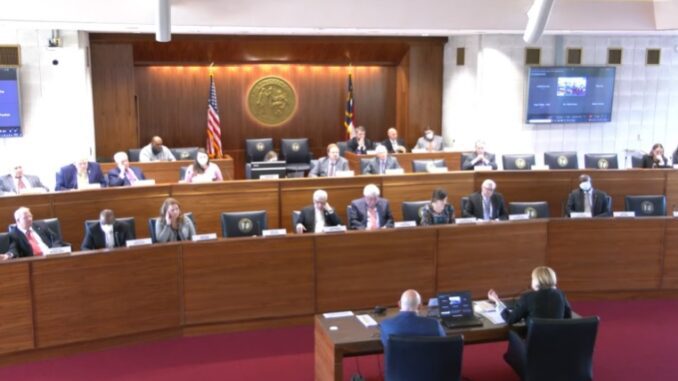
RALEIGH — A legislative subcommittee on COVID-19 heard from staff and top education officials about learning loss in K-12 at a Feb. 1 meeting.
Learning loss is defined by the state’s plans submitted to the federal government for educational pandemic relief funds as “academic impact of lost instructional time.”
The Joint Legislative Commission on Governmental Operations, Subcommittee on Use and Distribution on Federal COVID Funding heard from Alyssa Morrissey and Morgan Dunn, the Senate Governmental Operations Evaluators of Student-Level Accountability (SGOE).
Testimony also came from N.C. State Superintendent Catherine Truitt, and from Dr. Michael Maher of the Department of Public Instruction’s Office of Learning Recovery and Acceleration (OLR).
All of the presenters were asked to submit to an oath or affirmation statement before testifying.
Despite a March 2021 tweet from N.C. Association of Educators President Tamika Kelly claimed, “Learning loss is a false construct,” the testimony given to the subcommittee demonstrated the opposite, with Truitt remarking, “Learning loss is real.”
“One of the main lessons we learned from COVID-19 was the effects of remote learning. While it can be an incredible tool for some students, this method does not work for every student despite teachers’ best efforts,” Truitt said. “While some students succeeded and are still thriving in remote settings… most of our students struggled.”
Truitt later addressed mental health issues facing students due to lockdowns and continued COVID mitigation policies, stating the “mental trauma and health issues that we feared coming out of this pandemic are real and need to be taken seriously” and she appreciates the General Assembly increasing school psychologist allotments to address these issues.
“Because we’re talking about government agencies, namely DHHS, dictating the rules schools are having to live by and that that is part of the executive branch, it’s inherently become political,” Truitt said in response to legislator remarks about COVID-19 and related policies impacting student mental health.
She expressed concern about the fact a “local health director can overturn what a school decides to do or not do,” and said that she will be pressing N.C. Department of Health and Human Services officials at this week’s board meeting to “identify a goal post for when we can ask our students to stop masking.”
Very preliminary results show us that there were negative effects for students across all grades, which is what we anticipated,” Truitt said. “While we are still working through understanding the data with partners, we are seeing a trend where students who were brought back in the classroom for face-to-face learning and where specific and targeted resources and supports were immediately put in place, did better than the students who were purely remote and disengaged from their school community.”
Maher said they are working on “building a strategy for recovery” and are developing ways to determine where a student’s competency stands and where it should be. Maher’s office is analyzing current student achievement from 2020-2021 with what their projected scores should have been.
“Simply put, we will be able to understand the difference between actual and projected scores which will indicate the extent to which students’ academic performance deviated from their expected trajectories during the pandemic,” Truitt said of Maher’s work.
Maher’s presentation slide laid out the six areas the OLR is working within to address learning issues and the three “levers of change” that include state-sponsored learning recovery programs, the move towards competency-based learning, and research and evaluation of lost instruction time and learning recovery.
Truitt said that more data on the levels of learning loss will likely be gleaned from North Carolina Read to Achieve related requirements and the National Assessment of Educational Progress, often referred to as the Nation’s Report Card. She added she expects to see improvement in literacy following classroom implementation of the Science of Reading, a phonics-based program included in the Excellent Public Schools Act signed by the governor in April of 2021.
Alluding to remarks earlier in the meeting by Morrissey and Dunn, Maher said he felt “maligned,” and that his office does feel a sense of urgency surrounding learning loss.
Morrissey and Dunn’s presentation to the subcommittee included student achievement and subject proficiency comparisons between the 2019-2020 and 2020-2021 school years. The presentation looked at various tests and programs to address learning loss due to the pandemic.
The pair noted that the U.S. Dept. Of Education and North Carolina S.L. 2020-3 waived standardized testing and the requirement to report state accountability and growth measures for 2019-2020. As a result, the participation rate in the 2020-21 BOG was around 68 percent versus the typical 95 percent. Morrisey and Dunn said that regardless of that waiver, the data still shows significant learning loss.
When asked by legislators how North Carolina students faired overall, Morrissey said she can’t compare apples to apples, but that there were more drastic drops in math for older students and reading drops for younger students in comparison with neighboring states.
The learning losses of North Carolina students mirror that of students across the country, with a recent article in the Washington Post pointing out achievement and proficiency dropped significantly in 2020 and remained below norms in 2021. Additionally, there was a marked impact on minority students.
In order to be considered proficient at grade level, North Carolina third-grade students need to achieve level 3 or higher on the third-grade beginning of grade assessment (BOG), which is supposed to establish a student’s baseline reading competency. Any score below three is considered not proficient and requires “need significant support.”
Morrissey and Dunn’s presentation comparing 2019-20 and 2020-21 third-grade reading proficiency scores showed almost 50 percent of third-grade students in 2019-20 were at level one compared to 58.2 percent in 2020-21.
Another area the SGOE presentation included were reading and math summer learning programs during 2020 and 2021, both of which showed higher student eligibility rates than participation rates.
The 2021 summer reading camps had lower numbers of eligible students and corresponding lower levels of participation. Less than ten percent of participants at any of the three grade levels (first, second, and third) were rated proficient after attending.
Citing a report by the state auditor, Morrissey said that there were accountability issues with the way schools and districts kept attendance of the 2021 summer program. In some cases, a child was counted as having attended if they showed up for a single day of instruction.
Maher corrected those remarks, noting that the state auditor’s office had been referring to the 2020 program and not the 2021 summer program.
Following the 2021 summer program, SGOE reported 1,462 (8.7%) of the 16,789 attending second graders and 2,537 (6.8%) of the 17,317, third graders were considered proficient. Only 1,734 (9.2 percent) of the 18,862 first graders were proficient following the program.
North Carolina has received millions in federal pandemic-related funds over the past two years including $396 million as part of the Elementary and Secondary Schools Emergency Relief Fund (ESSER I) in March of 2020 as part of the CARES Act. Laws passed by the General Assembly governed the distribution of the funds.
Learning loss was not one of the permissible expenditures under ESSER I, and districts mainly used the money for PPE, technology, and bonus pay. Districts received 90 percent of ESSER I funds while the other ten percent, around $40 million, was held in reserve.
Since ESSER I, the state has received another $1.6 billion in ESSER II and $3.6 billion in ESSER III. The various funds were distributed through laws passed by the General Assembly, with a small percentage being held back in reserve over time.
ESSER III requires districts to use 20 percent of their funds to address learning loss. Another $36 million from the state’s reserves is to go towards summer learning programs.




